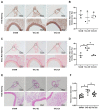Aerobic Exercise Prevents Arterial Stiffness and Attenuates Hyperexcitation of Sympathetic Nerves in Perivascular Adipose Tissue of Mice after Transverse Aortic Constriction
- PMID: 36232489
- PMCID: PMC9570255
- DOI: 10.3390/ijms231911189
Aerobic Exercise Prevents Arterial Stiffness and Attenuates Hyperexcitation of Sympathetic Nerves in Perivascular Adipose Tissue of Mice after Transverse Aortic Constriction
Abstract
We aimed to investigate the efficacy of exercise on preventing arterial stiffness and the potential role of sympathetic nerves within perivascular adipose tissue (PVAT) in pressure-overload-induced heart failure (HF) mice. Eight-week-old male mice were subjected to sham operation (SHAM), transverse aortic constriction-sedentary (TAC-SE), and transverse aortic constriction-exercise (TAC-EX) groups. Six weeks of aerobic exercise training was performed using a treadmill. Arterial stiffness was determined by measuring the elastic modulus. The elastic and collagen fibers of the aorta and sympathetic nerve distribution in PVAT were observed. Circulating noradrenaline (NE), expressions of β3-adrenergic receptor (β3-AR), and adiponectin in PVAT were quantified. During the recovery of cardiac function by aerobic exercise, thoracic aortic collagen elastic modulus (CEM) and collagen fibers were significantly decreased (p < 0.05, TAC-SE vs. TAC-EX), and elastin elastic modulus (EEM) was significantly increased (p < 0.05, TAC-SE vs. TAC-EX). Circulating NE and sympathetic nerve distribution in PVAT were significantly decreased (p < 0.05, TAC-SE vs. TAC-EX). The expression of β3-AR was significantly reduced (p < 0.05, TAC-SE vs. TAC-EX), and adiponectin was significantly increased (p < 0.05, TAC-SE vs. TAC-EX) in PVAT. Regular aerobic exercise can effectively prevent arterial stiffness and extracellular matrix (ECM) remodeling in the developmental course of HF, during which sympathetic innervation and adiponectin within PVAT might be strongly implicated.
Keywords: PVAT; arterial stiffness; exercise; heart failure; sympathetic nerves.
Conflict of interest statement
The authors declare no conflict of interest.
Figures





Similar articles
-
Chronic exercise training prevents coronary artery stiffening in aortic-banded miniswine: role of perivascular adipose-derived advanced glycation end products.J Appl Physiol (1985). 2019 Sep 1;127(3):816-827. doi: 10.1152/japplphysiol.00146.2019. Epub 2019 Jul 11. J Appl Physiol (1985). 2019. PMID: 31295062 Free PMC article.
-
Role of Sympathetic Nerves and Adipocyte Catecholamine Uptake in the Vasorelaxant Function of Perivascular Adipose Tissue.Arterioscler Thromb Vasc Biol. 2018 Apr;38(4):880-891. doi: 10.1161/ATVBAHA.118.310777. Epub 2018 Mar 1. Arterioscler Thromb Vasc Biol. 2018. PMID: 29496660
-
Aerobic exercise protects against pressure overload-induced cardiac dysfunction and hypertrophy via β3-AR-nNOS-NO activation.PLoS One. 2017 Jun 16;12(6):e0179648. doi: 10.1371/journal.pone.0179648. eCollection 2017. PLoS One. 2017. PMID: 28622359 Free PMC article.
-
Emerging Roles of Sympathetic Nerves and Inflammation in Perivascular Adipose Tissue.Cardiovasc Drugs Ther. 2019 Apr;33(2):245-259. doi: 10.1007/s10557-019-06862-4. Cardiovasc Drugs Ther. 2019. PMID: 30747398 Free PMC article. Review.
-
New actions of an old friend: perivascular adipose tissue's adrenergic mechanisms.Br J Pharmacol. 2017 Oct;174(20):3454-3465. doi: 10.1111/bph.13663. Epub 2016 Dec 4. Br J Pharmacol. 2017. PMID: 27813085 Free PMC article. Review.
Cited by
-
Perivascular adipose tissue: a central player in the triad of diabetes, obesity, and cardiovascular health.Cardiovasc Diabetol. 2024 Dec 28;23(1):455. doi: 10.1186/s12933-024-02549-9. Cardiovasc Diabetol. 2024. PMID: 39732729 Free PMC article. Review.
-
Association Between Mediterranean Diet and Other Healthy Habits and Sociodemographic Variables with the Values of Vascular and Heart Age in Spanish Workers.Nutrients. 2025 Mar 5;17(5):903. doi: 10.3390/nu17050903. Nutrients. 2025. PMID: 40077773 Free PMC article.
-
Sympathetic hyperinnervation drives abdominal aortic aneurysm development by promoting vascular smooth muscle cell phenotypic switching.J Adv Res. 2025 May;71:383-398. doi: 10.1016/j.jare.2024.05.028. Epub 2024 May 29. J Adv Res. 2025. PMID: 38821358 Free PMC article.
-
HIIT Promotes M2 Macrophage Polarization and Sympathetic Nerve Density to Induce Adipose Tissue Browning in T2DM Mice.Biomolecules. 2024 Feb 20;14(3):246. doi: 10.3390/biom14030246. Biomolecules. 2024. PMID: 38540669 Free PMC article.
-
Getting to the Heart of the Matter: Exploring the Intersection of Cardiovascular Disease, Sex and Race and How Exercise, and Gut Microbiota Influence these Relationships.Rev Cardiovasc Med. 2025 Feb 20;26(2):26430. doi: 10.31083/RCM26430. eCollection 2025 Feb. Rev Cardiovasc Med. 2025. PMID: 40026503 Free PMC article. Review.
References
MeSH terms
Substances
Grants and funding
LinkOut - more resources
Full Text Sources
Medical
Research Materials
Miscellaneous

